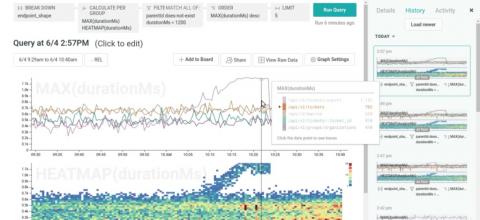Operations | Monitoring | ITSM | DevOps | Cloud
Latest Blogs
Gain Full Visibility into Microservices Architectures Using Kubernetes with Sumo Logic and Amazon EKS
Amazon Elastic Container Service for Kubernetes (Amazon EKS) is a managed service that makes it easyfor you to run Kubernetes on AWS without needing to install and operate your own Kubernetes clusters.
Monitor Amazon EKS with Datadog
Amazon Elastic Container Service for Kubernetes (EKS), the latest addition to the AWS platform, is a cloud-based Kubernetes service that provides features for automated cluster management and maintenance. Whether you are migrating an existing Kubernetes cluster or deploying a new application to Amazon EKS, Datadog can help you monitor your container infrastructure and applications in real time.
Elasticsearch Performance Tuning
Once you have your Elasticsearch running, you’ll likely eventually find that performance starts to suffer over time. This can be due to a variety of factors, including changes in the way you’re using your cluster to how much and what types of data are being sent in. In order to maintain your cluster, you’ll need to set up monitors to alert you to any warning signs so that you can proactively handle available maintenance windows.
New Release: Public Status Page | Breakdown and Use Case
Uptime Status Pages can now be shared publicly. You will find that they are a useful tool for information sharing under a variety of circumstances. Internal pages offer excellent insight for your team, but public status pages provide users and other parties helpful information about your services and websites.
AppDynamics Cloud Arrives in Europe
With the new privacy law updates in the form of the EU General Data Protection Regulation (GDPR), data privacy has become a hot topic. AppDynamics SaaS customers can be assured that AppDynamics and Cisco have also been preparing for GDPR readiness to help our customers with this new regulation.
AppDynamics Enhances Pivotal Cloud Foundry Performance Monitoring with New Infrastructure View
We’ve significantly expanded our Pivotal Cloud Foundry (PCF) performance monitoring capabilities, adding an intuitive dashboard, new metrics, and advanced capabilities to deliver powerful insights into your PCF applications.
Get deeper insights with Honeycomb Tracing
We’re excited to introduce Honeycomb Tracing! Now, you can both: Visualize individual traces to deeply understand request execution, and Break down, filter, and aggregate trace data to uncover patterns, find outliers, and understand historical trends.
Using Trend Analysis for Better Insights
Centralized log collection has become a necessity for many organizations. Much of the data we need to run our operations and secure our environments comes from the logs generated by our devices and applications. Centralizing these logs creates a large repository of data that we can query to enable various types of analysis. The most common types are conditional analysis and trend analysis. They both have their place, but trend analysis is perhaps the more often underutilized source of information.
Log Management Comparison: ELK vs Graylog
Production logs can help ensure application security, reveal business insights and find and understand errors, crashes, and exceptions. But as useful as logs are, they’re difficult to manage and hard to keep track of. Making matters worse is that as log data volume grows, so does the difficult task of maintaining and managing them. It’s for this reason that developers, DevOps engineers, and CTOs turn to log management tools.









